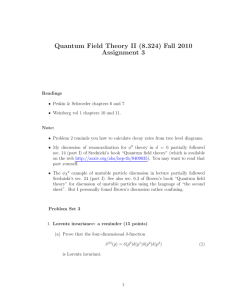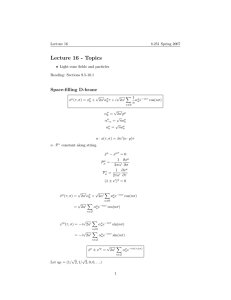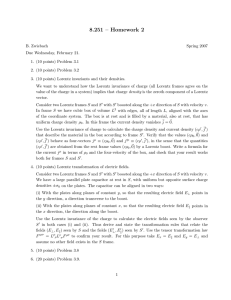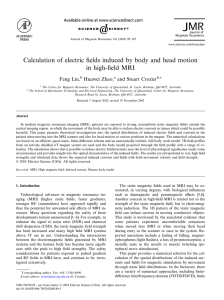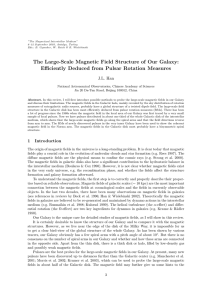Document 13650394
advertisement
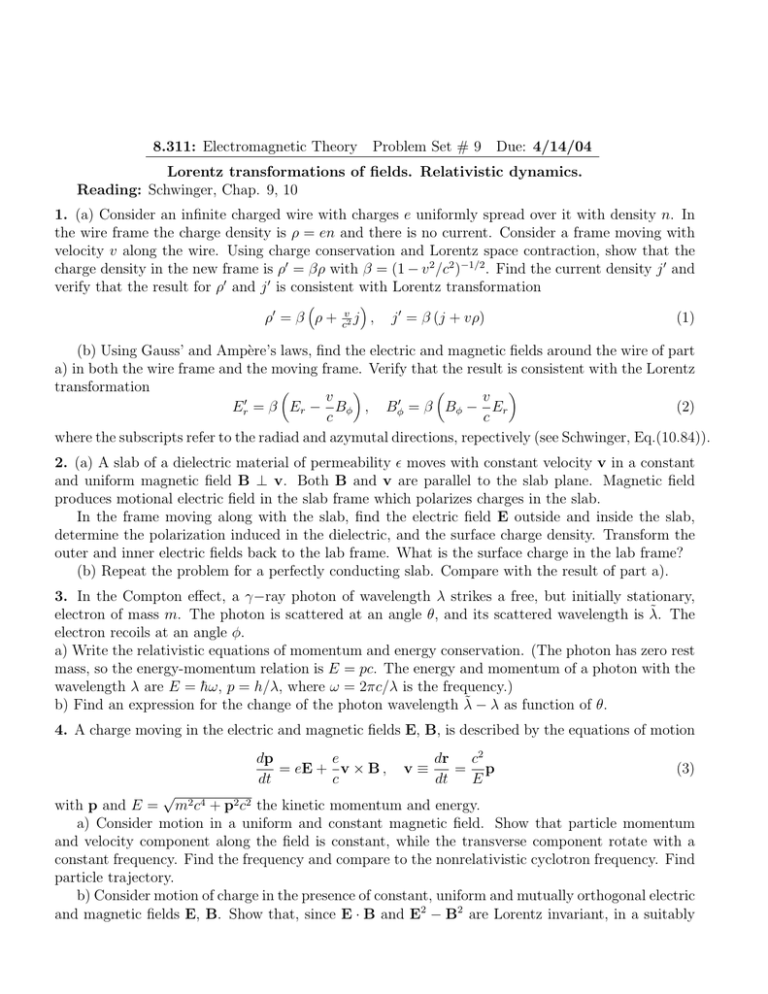
8.311: Electromagnetic Theory Problem Set # 9 Due: 4/14/04 Lorentz transformations of fields. Relativistic dynamics. Reading: Schwinger, Chap. 9, 10 1. (a) Consider an infinite charged wire with charges e uniformly spread over it with density n. In the wire frame the charge density is ρ = en and there is no current. Consider a frame moving with velocity v along the wire. Using charge conservation and Lorentz space contraction, show that the charge density in the new frame is ρ� = βρ with β = (1 − v 2 /c2 )−1/2 . Find the current density j � and verify that the result for ρ� and j � is consistent with Lorentz transformation � ρ� = β ρ + v j c2 � , j � = β (j + vρ) (1) (b) Using Gauss’ and Ampère’s laws, find the electric and magnetic fields around the wire of part a) in both the wire frame and the moving frame. Verify that the result is consistent with the Lorentz transformation � � � � v v � � Er = β Er − Bφ , Bφ = β Bφ − Er (2) c c where the subscripts refer to the radiad and azymutal directions, repectively (see Schwinger, Eq.(10.84)). 2. (a) A slab of a dielectric material of permeability � moves with constant velocity v in a constant and uniform magnetic field B ⊥ v. Both B and v are parallel to the slab plane. Magnetic field produces motional electric field in the slab frame which polarizes charges in the slab. In the frame moving along with the slab, find the electric field E outside and inside the slab, determine the polarization induced in the dielectric, and the surface charge density. Transform the outer and inner electric fields back to the lab frame. What is the surface charge in the lab frame? (b) Repeat the problem for a perfectly conducting slab. Compare with the result of part a). 3. In the Compton effect, a γ−ray photon of wavelength λ strikes a free, but initially stationary, electron of mass m. The photon is scattered at an angle θ, and its scattered wavelength is λ̃. The electron recoils at an angle φ. a) Write the relativistic equations of momentum and energy conservation. (The photon has zero rest mass, so the energy­momentum relation is E = pc. The energy and momentum of a photon with the wavelength λ are E = hω, ¯ p = h/λ, where ω = 2πc/λ is the frequency.) b) Find an expression for the change of the photon wavelength λ̃ − λ as function of θ. 4. A charge moving in the electric and magnetic fields E, B, is described by the equations of motion dp e = eE + v × B , dt c v≡ dr c2 = p dt E (3) √ with p and E = m2 c4 + p2 c2 the kinetic momentum and energy. a) Consider motion in a uniform and constant magnetic field. Show that particle momentum and velocity component along the field is constant, while the transverse component rotate with a constant frequency. Find the frequency and compare to the nonrelativistic cyclotron frequency. Find particle trajectory. b) Consider motion of charge in the presence of constant, uniform and mutually orthogonal electric and magnetic fields E, B. Show that, since E · B and E2 − B2 are Lorentz invariant, in a suitably chosen moving frame one of the fields can be made vanish. Then there is only B and no E, or only E and no B. Find particle trajectory. 5. Consider the relativistic Kepler problem: a point charge e of mass m moving in the field of a static point charge −e. Write down the Lagrangian in cylindrical coordinates: � L = −mc2 1 − (ρ̇2 + ρ2 ϕ̇2 )/c2 + e2 , ρ (4) where it is assumed that the trajectory is in the z = 0 plane. Show that the angular momentum M = ∂L/∂ϕ̇ and the energy E = ρ∂L/∂ρ̇ + ϕM ˙ − L are conserved. From that, derive a first order ˙ differential equation for ρ(t). (a) Consider circular trajectories. Derive the analog of Kepler’s radius­period relationship. (b) Find ρ(ϕ) for a general non­circular trajectory. Show that, unlike the nonrelativistic problem, the frequencies of radial and angular motion are different. As a result, instead of a closed trajectory, one obtains a more complex tra jectory that can be represented as a precessing Kepler ellipse. Find the rate of precession in the non­relativistic limit v � c. 6. A rocket having initially a total mass M0 ejects its fuel with constant velocity −u (u > 0) relative to its instantaneous reference frame. (a) Show that, according to nonrelativistic Newtonian mechanics, the rocket velocity v, relative to the inertial frame in which it was initially at rest, is related to rocket mass M (v) by the formula M v = exp − M0 u � � (5) (b) Suppose that the fuel ejection velocity u is limited only by 0 < u < c, and derive the relativistic analog of the above equation. Check that it reduces to the Newtonian result in the limit u � c.

